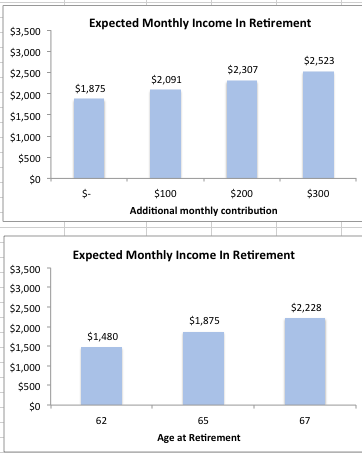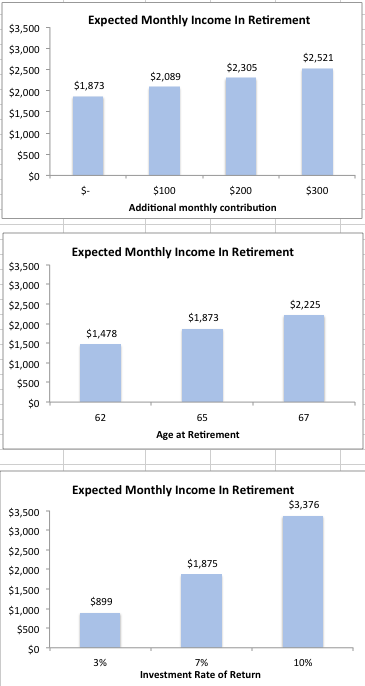Focus Groups
Focus Groups and Survey Regarding Pension Benefit Statements
Sample Statement V2 5-28-13
Focus Groups
OMB: 1210-0151
Sample 401(k) Plan Statement for John Doe
Plan Name XXXX
Quarterly Retirement Plan Statement, 6/30/12
For more information about your plan, contact (XXX) 555-5555
Account Information
Account Balances |
|
Explanation |
End of statement period |
$102,105.53 |
This is the total amount of money in your account on 6/30/2012 |
Beginning of statement period |
$97,000.26 |
This is the total amount of money in your account on 4/1/2012 |
Vested account value |
$66,251.74 |
This is the amount of money in your account that you currently own (you do not own all money that your employer contributes to your account right away, you earn it over time) |
Investment Allocation |
Beginning of period (4/1/12) |
End of period (6/30/12) |
Percentage of account (6/30/12) |
XYX Institutional Fund (Large cap stock fund) |
$41,710.11 |
$43,190.64 |
42.3% |
ABCD Management Fund (Mixed Stock Bond fund) |
$55,290.14 |
$58,914.89 |
57.7% |
To help achieve long-term retirement security, you should give careful consideration to the benefits of a well-balanced and diversified investment portfolio. Spreading your assets among different types of investments can help you achieve a favorable rate of return, while minimizing your overall risk of losing money. You may not be adequately diversified if you hold more than 20 percent of your portfolio in the security of one entity (such as employer securities) or industry. Although diversification is not a guarantee against loss, it is an effective strategy to help you mange investment risk.
Activity
This section shows the activity in your account in the period of time shown
Activity |
Last Period (since 4/1/12) |
Year to Date (since 1/1/12) |
Explanation |
1. Contributions / withdrawals |
|
|
|
Your contributions |
$1,253.01 |
$2,506.03 |
This is the total contribution you made |
Your employer’s contributions |
$250.60 |
$501.21 |
This is the total contribution your employer made |
Withdrawals |
($0) |
($0) |
This is the sum of your withdrawals |
SUBTOTAL |
$1,503.61 |
$3,007.23 |
This is the sum of contributions and withdrawals. |
2. Investment changes |
|
|
|
Investment gains and losses |
$3,722.07 |
$5,120.78 |
This is the total amount your account gained or lost due to changes in the value of your investments. |
General plan administrative service fees |
($120.40) |
($235.99) |
These include fees to legal, accounting and recordkeeping that are actually charged to your account during the preceding quarter for such services.
|
Individual fees and expenses |
($0) |
($0) |
These include fees for processing plan loans or qualified domestic relations orders, investment advice, brokerage windows, commissions, front- or back-end loads or sales charges, redemption, transfer and optional rider charges in annuity contracts that are actually charged to your account during the preceding quarter for such services.
|
SUBTOTAL |
$3,601.67 |
$4,884.79 |
This is the sum of investment gains, losses and fees. |
Change in account value |
$5,105.28 |
$7,892.02 |
This is the total increase or decrease in your account value in the period of time shown. It is the sum of 1 and 2. |
For more information about your plan, contact (XXX) 555-5555
Projections
This section shows (1) total account values, (2) the monthly income these total account values could generate for you after you retire, and (3) the monthly income these total account values could generate after you retire for a spouse who survives you.
All future projections are shown in today’s dollars, which account for inflation. Inflation changes the purchasing power of money. Presenting your projections in today’s dollars will give you an idea of how much you could buy with your retirement account when you retire.
Caution: projected values at retirement are only estimates.
|
1. Account Value |
2. Monthly Income after Retirement |
3. Survivor Monthly Income |
A. Estimated for Current Account Value |
$102,105.52
|
$351.12 |
$175.56 |
B. Projected at Retirement1 |
$545,376.27 |
$1,875.42 |
$937.71 |
All calculations on this page use the following information and assumptions:
Your current age is 40
Your account balance as of June 30, 2012
The average life expectancy for a man of this age
Retirement at age 65
A joint-survivorship annuity purchased at age 65, with level payments, assuming the person and his/her spouse are the same age, and survivor benefits are equal to 50% of the monthly payment with no other additional features. The value of the annuity shown reflects current market pricing at the time of this statement.
Calculations in Row A use:
An inflation rate equal to the expect rate of return on your investment, with no further account contributions
Projections in Row B use:
An inflation rate of 3%
An expected rate of return on your investments of 7%, which after inflation would be 4%
D. Factors that could change monthly income at retirement
Suppose that you continue making contributions to your plan until you retire.
How much can I gain if I make additional contributions?
T
 his
graph shows your expected monthly income at retirement if you decide
to increase current contributions to your retirement account. The
graph shows this expected monthly income if you contributed $100,
$200 and $300 more each month until you retire.
his
graph shows your expected monthly income at retirement if you decide
to increase current contributions to your retirement account. The
graph shows this expected monthly income if you contributed $100,
$200 and $300 more each month until you retire.
The more you contribute, the more you save and the more you can expect to withdraw in the future.
For example, if you make $100 more each month in contributions starting today, then you can expect to get approximately $216 more each month when you retire ($2091 versus $1875). For $200 more in contribution each month now, you could expect to get approximately $432 more each month when you retire ($2307 versus $1875).

How much can I gain from working longer?
This graph shows your expected monthly income at retirement if you decide to change the age when you retire.
The longer you work, the more you save and the more you can expect to withdraw in the future.
For example, if you retire in 27 years, then you can expect to get approximately $353 more each month when you retire ($2228 versus $1875) than you would if you retired in 25 years. If you retire in 22 years, then you can expect to get $396 less each month when you retire ($1480 versus $1875).
H
 ow
much could I expect to gain or lose depending on the performance of
my investments?
ow
much could I expect to gain or lose depending on the performance of
my investments?
This graph shows your expected monthly income at retirement and how it depends on the rate of return on your investment portfolio from now until you retire.
The better your investments perform, the more valuable your savings will be, and the more you can withdraw in the future. On the other hand, if your investments do not perform well, you will accumulate less.
For example, if your average return is 10%, then you could get approximately $1501 more each month when you retire ($3376 vs. $1875) than you would if your average return is 7%. If your average return is 3%, then you could get approximately $976 less each month when you retire ($899 vs. $1875).
Caution: expected values at retirement are only guesses.
Expected values shown on this page account for inflation.
Unless otherwise noted, all projections on this page were calculated using the following information and assumptions:
You are currently age 40.
Your account balance as of June 30, 2012
A joint-survivorship annuity, with level payments, assuming the person and his/her spouse are the same age, and survivor benefits are equal to 50% of the monthly payment with no other additional features
An annuity interest rate of 4%
An inflation rate of 3%
An expected rate of return on your investments of 7%, which after inflation would be 4%
1 This projection assumes that your current employer contributions and your personal monthly contributions shown on page 1 increase annually at the same rate as inflation
| File Type | application/vnd.openxmlformats-officedocument.wordprocessingml.document |
| Author | Lauren Fleishman |
| File Modified | 0000-00-00 |
| File Created | 2021-01-29 |
© 2025 OMB.report | Privacy Policy